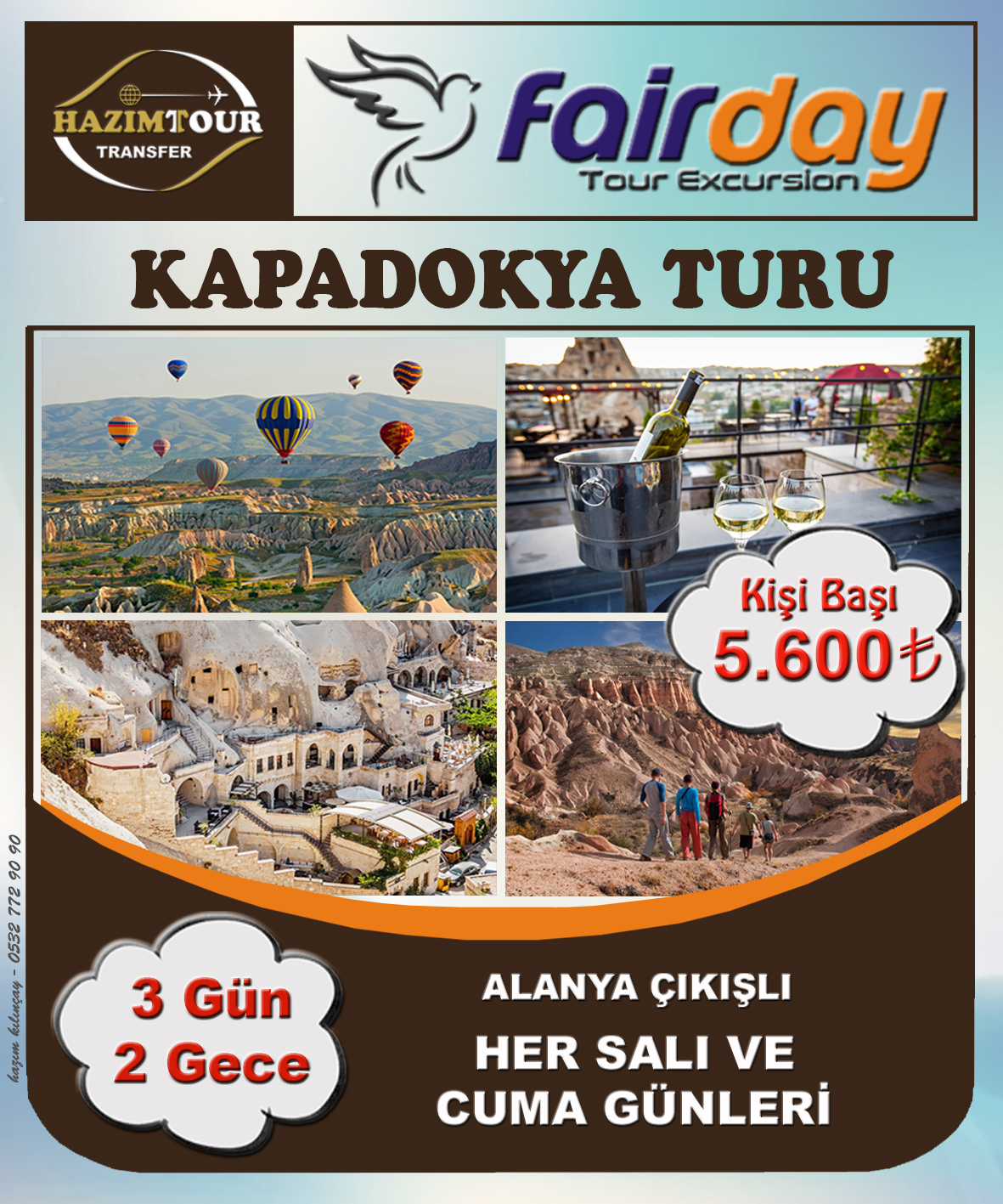
KAPADOKYA TURU :
Kapadokya, 60 milyon yıl önce Erciyes, Hasandağı ve Göllüdağ’ın püskürttüğü lav ve küllerin oluşturduğu yumuşak tabakaların milyonlarca yıl boyunca yağmur ve rüzgâr tarafından aşındırılmasıyla ortaya çıkan bölgedir. Kapadokya adı en eski M.Ö. 6. yüzyılda Pers kaynaklarında görülür. Katpatuka olarak geçen bu ismin kaynağı belirsizdir. Bazı uzmanlar Luvi dilinde "Alçak Ülke" anlamına geldiğini öne sürmüşlerdir. Ama daha sonraki araştırmalar "aşağı, aşağıda" anlamına gelen "katta" zarfının Hititçe olduğunu, Luvi karşılığının ise "zanta" olduğunu göstermektedir. Persçe "İyi Atlar Ülkesi" anlamına geldiği söylense de Fotoğraf Sanatçısı Ozan Sağdıç, 12 Eylül döneminde generallerin Kapadokya ismini Yunanca olduğu için yasaklayacaklarını öğrenince bu deyimi uydurduğunu açıklamıştır. Ayrıca Pers dilinde "iyi atlar ülkesi" anlamına gelen kelime "Huv-aspa" diye geçer.
- Tur Süresi; 3 Gündür.
- Pakete Dahil Olanlar :
- Alım ve Geri Bırakma Hizmeti
- Tam Sigorta
- 2 Gece Yarım Pansiyon Otel Konaklaması
- Otelde Kahvaltı ve Akşam Yemeği
- Yeraltı Şehrinin Girişi
- Zelve Açık Hava Müzesi ve Paşabağ Girişi
- Profesyonel Turist Rehberi
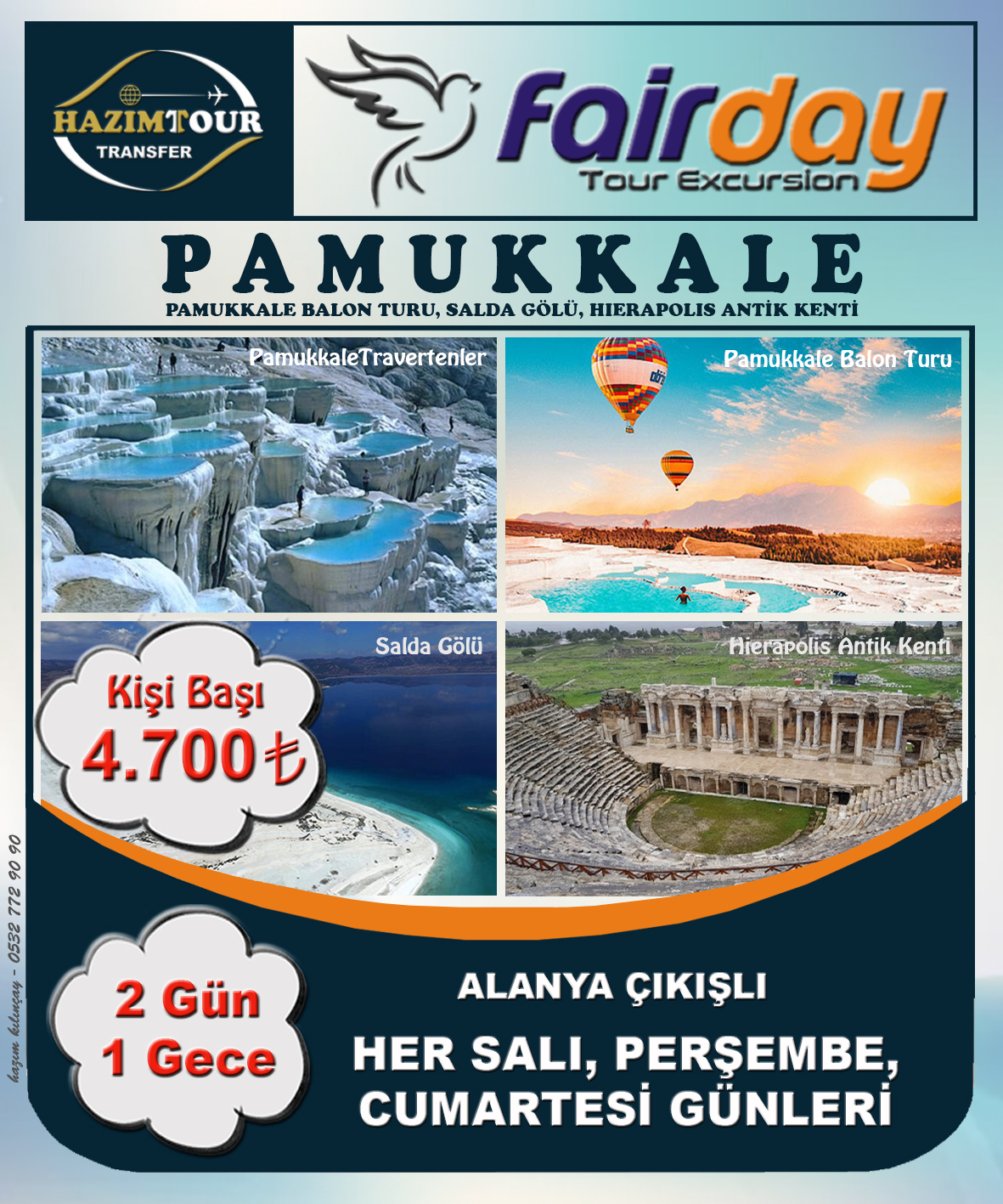
PAMUKKALE TURU :
Türkiye'nin Ege bölgesindeki Denizli iline bağlı doğal bir mevkidir. Şehir Kaplıcaları ve akan sulardan kalan karbonat minerallerin teraslarını, travertenlerini kapsamaktadır.
Eski Hierapolis kenti, toplam 2.700 metre uzunluğunda, 600 metre genişliğinde ve 160 metre yüksekliğindeki beyaz "kalenin" üzerine inşa edilmişti. Pamukkale Travertenleri, Denizli'nin 20 km uzaktaki merkezindeki vadinin karşı tarafındaki tepelerden görülebilir. 5–10 km yakınında Laodikya antik kenti bulunur. 5 km ilerisinde ise uluslararası bir termal merkez olan Karahayıt köyü vardır. Pamukkale UNESCO tarafından belirlenen Dünya Mirası listesinde yer almaktadır. Travertenler; görsel zenginliğin yanı sıra kalp rahatsızlıkları, romatizma, sindirim, solunum, dolaşım ve deri rahatsızlıklarına iyi gelmektedir.
- Tur Süresi; 2 Gündür.
- Pakete Dahil Olanlar :
- Alım ve Geri Bırakma Hizmeti
- Tam Sigorta
- 1 Gece Yarım Pansiyon Otel Konaklaması
- Otelde Kahvaltı ve Akşam Yemeği
- Pamukkale Girişi
- Profesyonel Turist Rehberi

THE LAND OF LEGENDS ( THEME PARK ) :
Antalya'da bulunan, dünyanın en büyük tema parklarından bir tanesidir. Otel, alışveriş merkezi ve tema parktan oluşmaktadır. The Land of Legends Rixos Hotels'e bağlıdır ve 2016'da Antalya'da kurulmuştur. 620.000m²'yi aşan bir arazinin üzerine inşa edilen park'ta Shopping Avenue, Kingdom Hotel ve Tema Park bölümleri yer almaktadır. 2017'de World Travel Awards - Avrupa'nın En İyi Tema Parkı ve World Waterpark Association – Leading Edge ödüllerine layık görülmüştür.
- PAKETE DAHİL OLANLAR :
- GÜNDÜZ PROĞRAMI :
- Alım ve Geri Bırakma Hizmeti
- Tam Sigorta
- Giriş Ücreti
- Tema Parkı
- Su Parkı
- Yunus ve Deniz Aslanları Gösterisi
- Maşa ve Ayı Animasyonu
- 5D Sinema
- Şezlong
- GECE PROĞRAMI :
- Alım ve Geri Bırakma Hizmeti
- Night Show
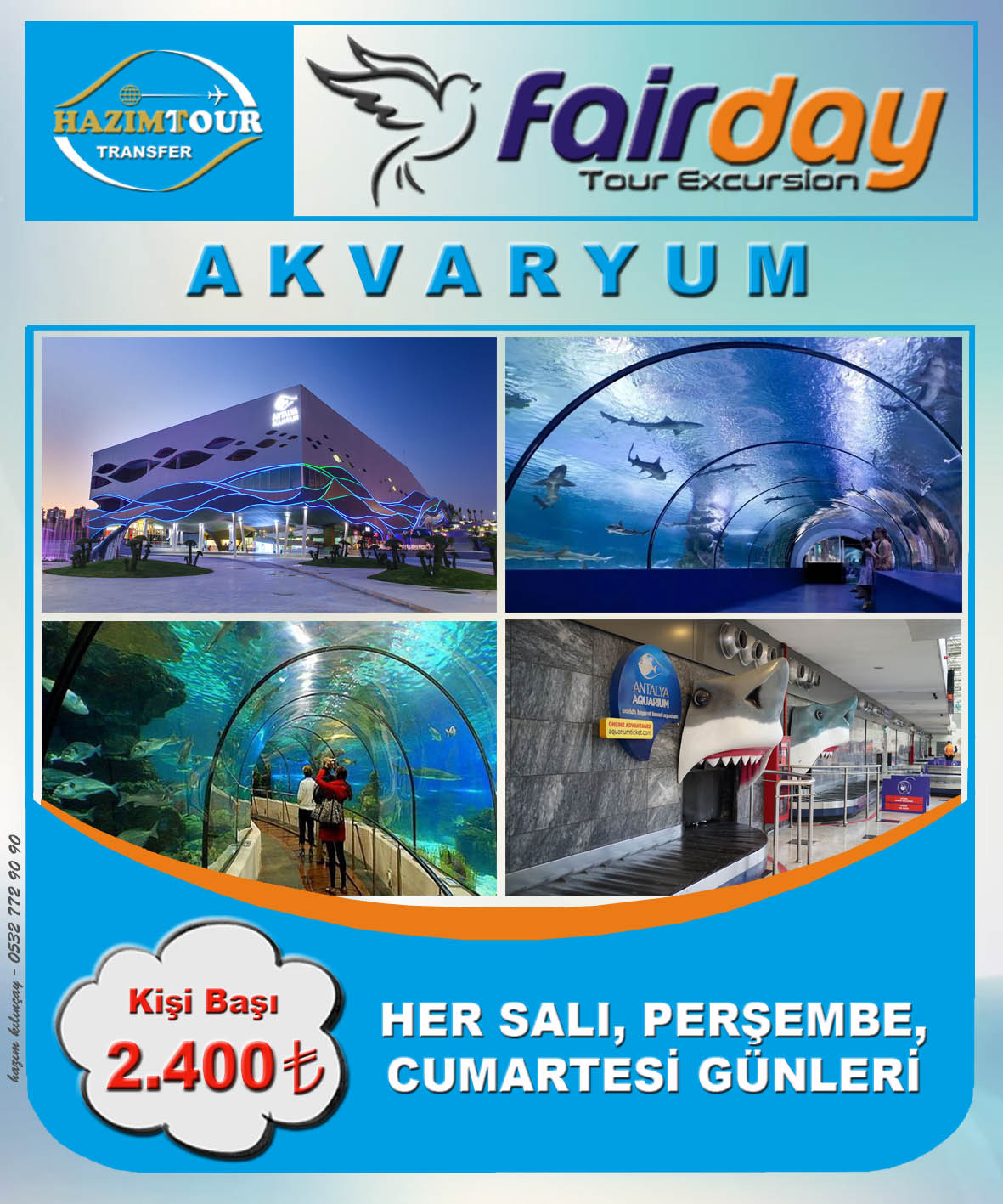
ANTALYA AQUARIUM :
Dünyanın en büyük akvaryum komplekslerinden biri olan Antalya Aquarium, ilham, eğlence ve eğitimi bir arada sunuyor. 40 tematik akvaryumun ardından 131 metrelik uzunluğu ve 3 metrelik genişliği ile dünyanın en büyük tünel akvaryumu Antalya Aquarium’da sizleri bekliyor. Antalya Aquarium dünyanın dört bir yanından hikayeler anlatıyor. Su altının sihirli dünyasını keşfedebileceğiniz gibi Snow World & Ice Museum’da gerçek kardan kar topları yapabilir, WildPark’da dünyanın en zehirli, en renkli ve en ilginç türleri arasında tropik bir maceraya adım atabilir, Oceanride XD Cinema’da Kaptan Barbossa ile dünya denizlerini çok boyutlu sinema teknolojisi ile gezebilirsiniz. Akvaryum gezinizi, Hollywood yeşil perde sistemi ile hazırlanan hatıra fotoğrafları ve özel hediyelik eşyalarla unutulmaz anılara dönüştürebilirsiniz. Macera dolu bir günü McDonalds, Mado ve GeLatte İtalyan Dondurması gibi ünlü lezzet seçenekleri ile tamamlayabilirsiniz. Antalya’nın kalbinde, tam şehir merkezinde Konyaaltı sahiline sadece 70 metre mesafede bulunan Antalya Aquarium, Antalya’nın en canlı cazibe merkezi. Antalya Aquarium, hayalgücünüzü keşfedin…
- PAKETE DAHİL OLANLAR :
- Alım ve Geri Bırakma Hizmeti
- Tam Sigorta
- Akvaryum Giriş Ücreti
- Balmumu Müzesi
- Şelale Girişi
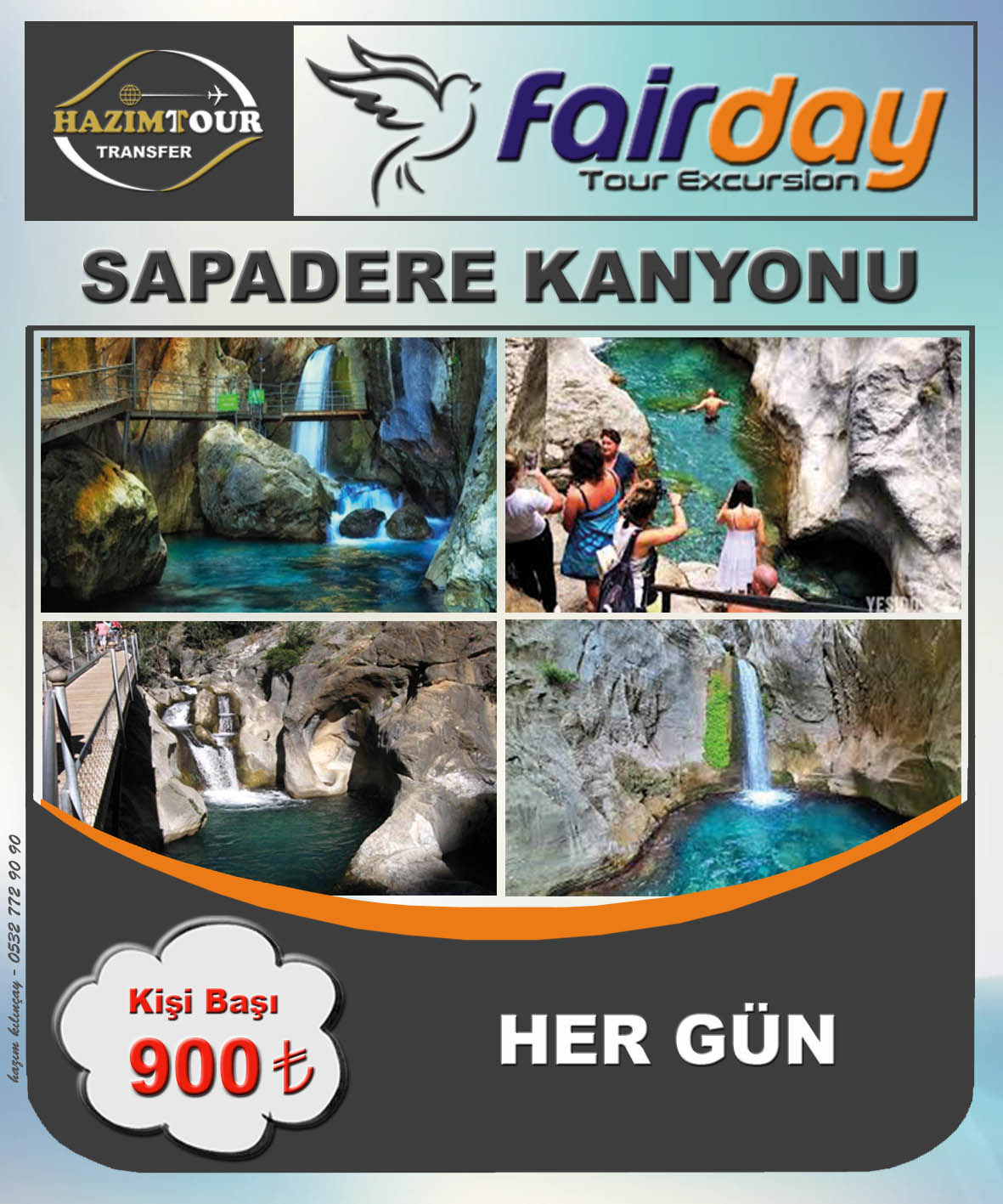
SAPADERE KANYONU :
Antalya ilinin Alanya ilçesi, Sapadere köyünde yer alan karstik oluşumlu kanyondur. Köye de adını veren Sapadere'nin oluşturduğu kanyonun uzunluğu 600 metre, yüksekliği 400 metredir.[1] Kanyonun oluşumunda Kireçtaşı bloklarının kimyasal ayrışması etkilidir. Sapadere'nin kanyondan çıktığı noktada, kanyonun tabanı coşkun akan dere tarafından kapatılmıştır. İç kısımlara geçmek için yan duvarlara demir çubuklarla doğaya uyumlu 600 metre uzunluğunda tahta köprü inşa edilmiştir. Altta akan suyun üzerinden geçtikten sonra kanyonun sonunda şelale yer alır. Şelalenin döküldüğü yerde suları epey soğuk olan dev kazanı (doğal havuz) oluşmuştur. Yaz mevsiminde bu doğal havuzun soğuk sularında yüzülmektedir. Yakın zamana kadar sadece çevre halkın bildiği kanyon, yerel yönetimlerin yaptığı tanıtım çalışmalarıyla turist çekmeye başlamıştır. Kanyon girişinde gelen misafirlerin temel ihtiyaçlarının karşılanabileceği yeme-içme mekanları vardır. Kanyonun uzaklığı Alanya'ya 45 kilometre, Antalya'ya 179 kilometredir. Antalya-Mersin yolu üzerinde Alanya'yı 24 kilometre geçtikten sonra Demirtaş beldesine gelinir. Demirtaş beldesinden asfalt yol ile Sapadere köyüne gidilir.
- PAKETE DAHİL OLANLAR :
- Alım ve Geri Bırakma Hizmeti
- Tam Sigorta
- Sapadere Kanyonu Giriş Ücreti
- Öğle Yemeği
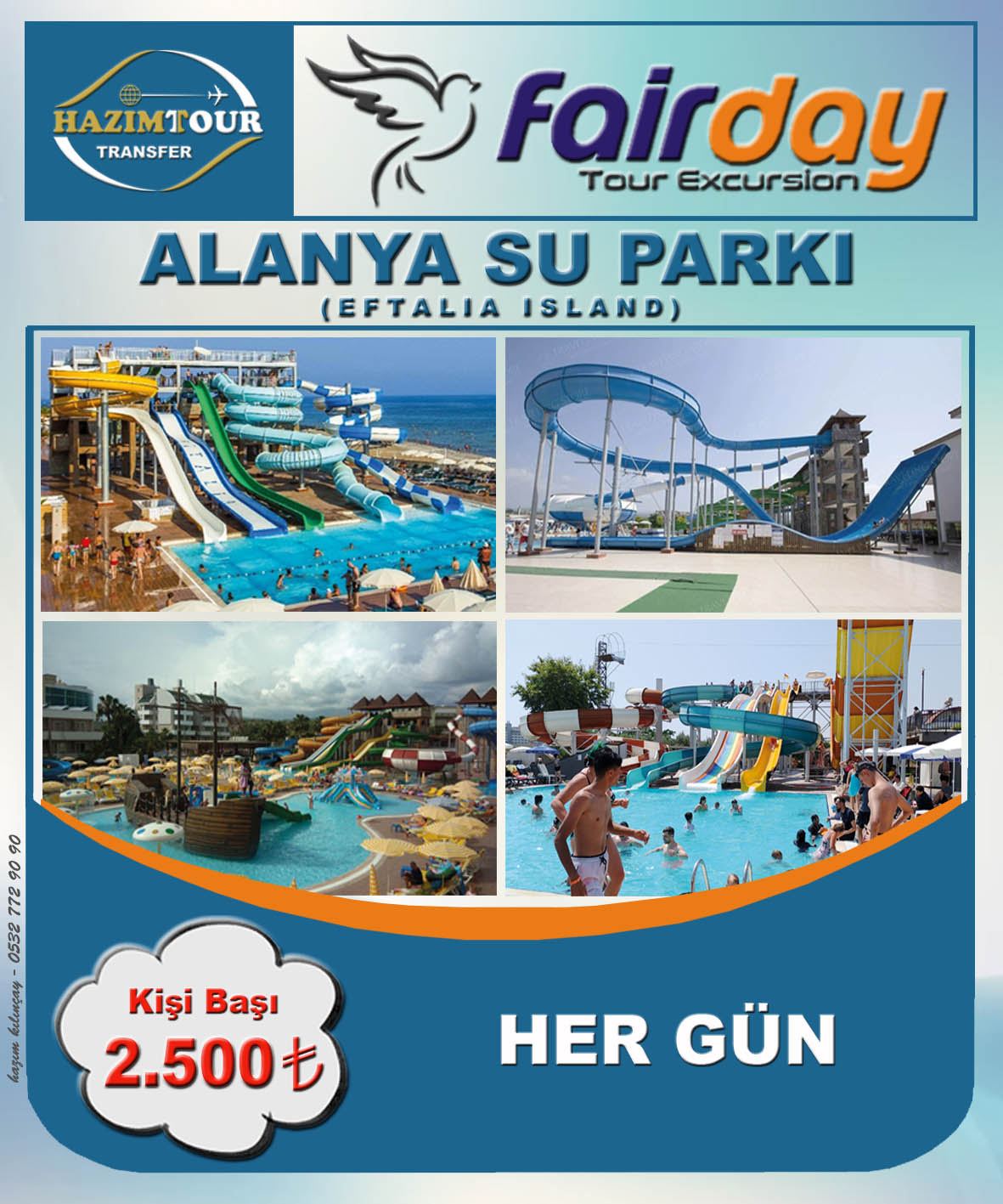
ALANYA SU PARKI ( Eftalia Island ) :
Antalya’nın öne çıkan tatil merkezlerinden Alanya’nın Türkler mevkiinde yer alan Eftalia Island, eğlence dolu bir tatilin kapılarını aralıyor. Denize yürüme mesafesinde hizmet veren tesiste konaklayan misafirler, ortak plaj alanı olan Eftalia Island’ın kum ve çakıl karışık plajından denize girebilir. Yeşili ve mavisi ile huzur veren bir doğada olma imkanı sunan tesis, farklı yaş gruplarına ve farklı zevklere hitap eden olanaklara sahip. Eftalia Aqua misafirleri, Eftalia Island bölümünde yer alan tüm renkli ve eğlenceli imkanlardan yararlanabiliyor. Barlar ve pavilyonlar, sessiz plaj, çocuklar ve yetişkinler için yüzme havuzları, aquapark eğlencesi, mini kulüp, SPA olanakları ve su sporları bu alanda yer alan olanaklar arasında bulunuyor. Misafirler tesisin SPA alanında thalasso havuzu, hamam, sauna ve masaj uygulamaları ile yenilenebilir. Heyecan arayan misafirler ise sörf, jet ski ve parasailing gibi farklı aktiviteler ile tatil coşkusunu doya doya yaşayabilir.
- PAKETE DAHİL OLANLAR :
- Alım ve Geri Bırakma Hizmeti
- Tam Sigorta
- Açık Büfe ( Pizza, Döner, Kebap v.b )
- Dondurma
- Alkolsüz İçecekler
- Bira ve Şarap